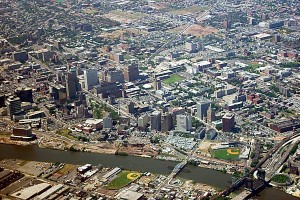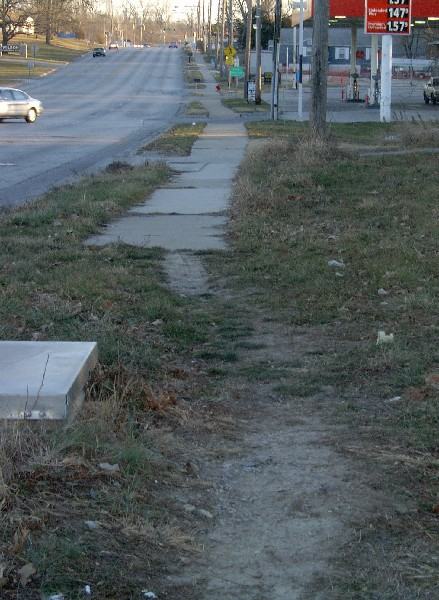New Jersey Future Blog
Newark Is Apparently Not a City Either
April 20th, 2012 by Tim Evans
Updated below.
When is a city not necessarily a city? When Wendell Cox is writing the definitions. In a recent article on the website New Geography, Cox resorts to some creative use of Census geography in an attempt to refute a growing body of evidence that urban areas are making a comeback.
The recent phenomenon of people (and businesses, and retail, and the developers who build for them) returning to places whose built environments provide a range of housing types and are designed to enable multiple transportation options – places including, but not limited to, the country’s biggest cities – has been well documented. Part of it is demographics – specifically the fact that the current generation of 20-somethings simply doesn’t want what the Baby Boomers did, and that employers are having to respond accordingly.
… people moving back into denser, downtown-style small towns and older suburbs supports the idea of a return to a pre-Interstate Highway-era settlement pattern. What is a sprawl apologist to do?
Also well documented is the fact that far-flung “exurban” (a term without any official definition, by the way) developments have been the hardest-hit places in the current recession and may not rebound any time soon.
Some of New Jersey Future’s own research reinforces these points; finding, for example, that building permit activity in older, built-out towns hasn’t fallen off as dramatically as it has in sprawling suburbs, and that transit-accessible towns have generally been more recession-resistant.
Plenty of smaller cities, towns, and older “streetcar” suburbs offer many of the same advantages of the big cities in terms of affordability and accessibility: a variety of housing types (including single-family homes on smaller lots) affordable to a range of incomes; shops and entertainment within walking distance; accessibility to public transportation; and grid-like street networks that facilitate shorter local car trips not requiring use of the regional road network. And many such places are indeed gaining population, some for the first time in decades.
Some urban commentators, Wendell Cox and Joel Kotkin among them, apparently find this phenomenon threatening and are attempting to muddy the waters. The “problem” for them (and this is only a problem if you’re seeking to discredit the notion that there might be people out there who don’t want to live in spread-out, single-use, cul-de-sac suburbia) is that people moving back into denser, downtown-style small towns and older suburbs supports the idea of a return to a pre-Interstate Highway-era settlement pattern. What is a sprawl apologist to do?
Why not just tally some of those newly revitalizing smaller urban areas in the column that supports your pro-sprawl argument, rather than in the column that undermines it?
One option is to pretend to misunderstand the point by concentrating on the fact that suburbs and exurbs are still growing faster than cities. This is generally true, but it does not in itself refute the thesis that urban areas are nonetheless experiencing a kind of renaissance. The yardstick by which the recent performance of older urban areas is so remarkable is in comparison to these same areas’ performance in prior decades, not in comparison to suburban growth (however you define it – see below).
But another tactic is even simpler: Why not just tally some of those newly revitalizing smaller urban areas in the column that supports your pro-sprawl argument, rather than in the column that undermines it? You can do this by defining “suburb and exurb” so broadly that it includes everything but the biggest cities. By doing so, you are effectively taking data that contradicts your preferred narrative and using it instead to bolster that narrative. That’s what Joel Kotkin has been doing, and it’s what Wendell Cox is doing in this more recent New Geography article. Cox’s concept of a “suburb” is even more inclusive than Kotkin’s, capturing not just Jersey City (among others) but Newark, New Jersey’s largest city.
As with Kotkin, Cox’s sleight of hand lies in the selective use of Census Bureau geography to construct a definition of “suburb” that meets his narrative needs. Cox defines “core counties” (the only counties he tallies in the “urban” column) as the counties that contain their metropolitan areas’ largest cities; “suburban” counties as those counties classified by the Census Bureau as “central” counties (pdf) of their metro areas (see, in particular, page 37250 for a discussion of “central counties”) but not containing the metro area’s largest city; and “exurban” counties as those that are part of a metro area but are not one of the central counties.
These definitions may initially seem defensible, but their application in New Jersey will very quickly illustrate how flawed they are. In particular, consider that 16 of New Jersey’s 21 counties are part of either the New York or Philadelphia metropolitan areas. Because both of those biggest-in-their-metro-area cities (and the counties that comprise them) are located in other states, there is no way for any of the New Jersey counties that are contained in their respective metro areas to be classified as “core” counties in Cox’s typology, no matter how palpably urban some of their constituent cities and towns (e.g., Newark, Jersey City, Elizabeth, Paterson, Camden) may be.
Here is how Cox’s classification plays out for the metropolitan areas that contain at least one New Jersey county:
For the New York City metro area:
Core counties: the 5 boroughs of New York (each of which constitutes its own county)
Suburban counties: Nassau, Suffolk, Westchester, Rockland, and Putnam counties in New York; Bergen, Passaic, Hudson, Essex, Union, Morris, Middlesex, Somerset, Hunterdon, Monmouth, and Ocean counties in New Jersey
Exurban counties: Sussex County, New Jersey; Pike County, Pennsylvania
For the Philadelphia metro area:
Core county: Philadelphia County (coextensive with the city of Philadelphia)
Suburban counties: Bucks, Montgomery, Delaware, and Chester counties in Pennsylvania; Burlington, Camden, Gloucester, and Salem counties in New Jersey; New Castle County, Delaware; and Cecil County, Maryland
Exurban counties: none
In addition, we have the following New Jersey counties making up parts of smaller metro areas:
Atlantic – core (and only) county of the Atlantic City-Hammonton metro area
Cape May – core (and only) county of the Ocean City metro area
Cumberland – core (and only) county of the Vineland-Millville-Bridgeton metro area
Mercer – core (and only) county of the Trenton-Ewing metro area
Warren – suburban county of the Allentown-Bethlehem PA-NJ metro area
Tallying up all of New Jersey’s 21 counties, we find that, using Cox’s terminology, New Jersey is composed of:
Four “core” counties: Atlantic, Cape May, Cumberland, and Mercer
16 “suburban” counties: Bergen, Passaic, Hudson, Essex, Union, Morris, Middlesex, Somerset, Hunterdon, Monmouth, Ocean, Warren, Burlington, Camden, Gloucester, and Salem
One “exurban” county: Sussex
That’s right – Cumberland (2010 population density = 317 people / sq. mi.) and Cape May (440 / sq. mi.) counties are “core” counties, while Hudson (16,070 / sq. mi.) and Essex (6,138 / sq. mi.) are “suburban.” If this sounds right to you, then you are likely to find the rest of Wendell Cox’s argument persuasive.
Consider, also, this list of projects that have been recipients of a New Jersey Future Smart Growth Award over the last 10 years:
- The South Waterfront project in Hoboken
- Eleven80, the conversion of an office building in downtown Newark into luxury apartments
- Lafayette Gardens, the conversion of a public housing project and a former industrial site into a mixed-income neighborhood in Jersey City
- Harrison’s plan to transform its disused industrial waterfront into a transit-oriented mixed-use neighborhood
- The redevelopment of the former Military Ocean Terminal in Bayonne
- The mixed-use Heldrich redevelopment project in New Brunswick
- The conversion to apartments of the RCA Victor building in Camden
- The construction of a mixed-use condominium project on a former lumber yard next to the PATCO transit station in Collingswood
- Wesmont Station, a new development (featuring a new train station) to be built on the site of an old airplane factory in Wood-Ridge
- The construction of new apartments and retail, including a food market, on two surface parking lots in Princeton
- Park Square, a mixed-use apartment complex on former surface parking lots in downtown Rahway
- The conversion into residential, retail, and office space of an old department store in downtown Morristown
- Gaslight Commons, a transit-oriented development in South Orange
- A plan for a new neighborhood on an abandoned landfill site in downtown Somerville
- More than 100 acres of redevelopment and infill development in downtown Metuchen
- Cranford Crossing, the largest redevelopment project undertaken in downtown Cranford in a century
At New Jersey Future, we consider all of these projects to be laudable examples of redevelopment in already-urbanized, pedestrian-friendly, and often transit-supportive areas. But by Cox’s definitions, the population growth engendered by these projects would all be tallied in the “suburban growth” column, because all of these host municipalities – despite their high population densities, as noted below, and built-out development footprints – are located in “suburban” counties:
- Hoboken (one of the most densely-populated municipalities in the country) – 39,776 people / sq. mi.
- Jersey City (total 2010 population of 247,597) – 16,730 people / sq. mi.
- Newark (New Jersey’s largest city, with a 2010 population of 277,140) – 11,413 people / sq. mi.
- Harrison – 11,121 / sq. mi.
- Bayonne – 10,833 / sq. mi.
- New Brunswick – 10,257 / sq. mi.
- Camden – 8,248 / sq. mi.
- Collingswood – 7,131 / sq. mi.
- Wood-Ridge – 6,966 / sq. mi.
- Princeton – 6,802 / sq. mi.
- Rahway – 6,713 / sq. mi.
- Morristown – 6,070 / sq. mi.
- South Orange – 5,662 / sq. mi.
- Somerville – 5,127 / sq. mi.
- Metuchen – 4,869 / sq. mi.
- Cranford – 4,612 / sq. mi.
For purposes of comparison, the overall 2010 population density of New Jersey – the most densely populated state in the nation – is 1,171 people per square mile.
As real estate expert Chris Leinberger states, the old “city vs. suburb” model is outdated; the real distinction is between “walkable urbanism” (which can be found throughout many older metropolitan areas, not just in the principal city) and “drivable sub-urbanism.” Cox’s oversimplified, county-based typology is too coarse to capture the difference. In fact, it’s likely to lead to conclusions that are the 180-degree opposite of what’s actually happening.
UPDATE: There has been a lot of Twitter activity about this article, including this from Twitter user Market Urbanism, to which Tim Evans responds in the comments below:
[blackbirdpie url=”http://twitter.com/#!/MarketUrbanism/status/196331840007708673″]


















On the plus side, maybe the fact that all of these Smart Growth Award winners are located in “suburbs” will help allay Mr. Cox’s fears that planners and smart-growth advocates are engaged in a war on suburbia.
I grew up in Hunterdon. It’s 1.5 hours from Manhattan and shares a border with Pennsylvania.
No Wendell Cox, Hunterdon County is not a suburb of NY by any stretch of the imagination, and neither are half the counties you’ve included there.
Newark is a city, but it’s a suburb of New York City.
Long Beach is a city, but it’s a suburb of Los Angeles, and so on.
It’s not Coxes/Kotkin’s sleight of hand since all the data came from Census figures.
Suburbs take many forms of urbanity, but what distiniguishes primarily for demographic purposes is their subordinate role to the larger core city. Since not the author, or anyone else can define “suburban” useful enough for any unit of comparison. You mindlessly throw tired tropes of “cul-de-sac suburbias” and “sprawl” like it has any objective meaning. And there’s absolutely no one out there identifying where “walkable urbanism” are located (notice you even had to put that term in quotes).
Newark is not a suburb of NYC.
Newark was founded in 1666 as the final Puritan attempt
to start a new world colony after their New Haven colony
was focibly annexed to connecticut colony by the king of England.
Newark is America’s third oldest Major City.
In 1916, it was America’s 12th largest city 2nd largest industrial city (Only Detroit surpassed it) & Economically
independent of New York.
But every city in America left it behind because NJ
strangled it by severing The Caldwells, The Oranges,Bkoomfield, Every inch of Essex County was once coextensive with Newark.
Then NJ passed home rule laws making annexation impossible.
I grew up in Hoboken. I’m extremely familiar with Jersey City and Newark. The idea that Newark and Jersey City are suburbs due to their proximity to New York is laughable. The majority of residents do not commute to New York City for work. They have their own economies. For example, Newport, Jersey City, has a ton of banking and finance.
Newark and Jersey City benefit from their proximity to New York, but are very much their own distinct URBAN entities. Anyone who has actually been there would agree.
Additionally, I realize that Cox did not mean to slight these cities, and has probably never been to Jersey City or Newark and didn’t give them a second thought.
Noah is spot on. While surely some Newark residents commute to NYC, Newark has its own historic downtown with a large and vibrant workforce. There are distinct Newark rush hours, where people from the region surrounding Newark commute into and out of the city. Anyone even remotely familiar with the city can attest to that. Big employers in Newark include insurance (Prudential being a big one), NJ Transit (the country’s its headquarters there), newspaper (the Star-Ledger, NJ’s largest newspaper, is in Newark), utilities (PSEG), etc. In addition, 4 universities are located in downtown Newark, bringing students, professors, and other workers into the city. It has one of the east coast’s biggest ports, and one of the largest airports. Calling this a suburb is simply absurd.
In addition, Hudson County is the 6th densest county in the nation, only trailing 4 NYC counties and San Francisco. If this is suburban, then no other city besides SF and NYC can be considered urban, which is ridiculous.
Cox and Kotkin were never considered credible academics, and these distortions and lies simply confirm what everyone already knew. What drives this type of behavior? Do they honestly believe this crap?
Um, Apologetic California, I challenge you to find anyone who knows those places would say that a Newark (or Hoboken, or Jersey City) resident lived in “the suburbs.” It may not have a strict technical definition, but there there is a commonly accepted set of meanings, none of which are captured by this silly exercise. Meanwhile, there can be pretty concrete measures about whether an area is walkable or requires a car to get anywhere from.
Apologetic California — as my original post suggested, and as the other commenters here have reinforced, I think you are wrong in your assertion that “…what distinguishes [suburbs] primarily for demographic purposes is their subordinate role to the larger core city.” Or maybe you’re right that that’s what demographers care most about, but it’s not what planners care about and not what we’re talking about here. The smart growth community generally uses the word “suburban” as it is used to describe development patterns, not as it is used to describe a place’s location relative to a larger place.
The lines that define the boundaries of cities – and thence define “suburb” in the geographic sense – are arbitrary anyway. Hoboken and Jersey City and the rest of Hudson County are way more densely populated than Staten Island, which is officially part of New York City. Which one is more “city”-like and which one is more “suburban”? I don’t find the geography-based meaning of “suburb” particularly useful.
We need to disentangle the geographic meaning of the word “suburb” (i.e. anything that isn’t the biggest city in the area) from the design meaning (low density, single-use, branching street network rather than grid). Otherwise people will be talking past each other in any discussion of suburbia.
This is why I like Chris Leinberger’s terminology of “walkable urbanism” vs. “drivable suburbia” (which I put in quotes here and in the post because they’re Leinberger’s terms — click the link immediately preceding my use of the term to read more). It declines to engage in an essentially pointless city-vs-suburb debate based on artificial geographic concepts and instead focuses on the design differences and commonalities that determine how people actually experience different types of places and navigate around them.
Incidentally, I wonder how people referred to places like Hoboken or Montclair or New Brunswick before Levittown created the concept of “suburbia” in the public imagination in the 1950s. There have always been places that were not the big city. Were they called “suburbs” back then? If you don’t have a good answer for this, you’ll understand why I generally try to discourage people from using terms like “suburb” and “sprawl” which, when it comes down to it, are laden with value judgements. Best to just identify and quantify what you think is dysfunctional about development patterns and focus on labeling that, rather than trying to force it into a larger ideological package.
My post has elicited a somewhat disappointing response from Market Urbanism, whose writing I otherwise enjoy.
First, Market Urbanism’s reply reads like an implicit defense of Cox as someone who did the best he could with a dataset that is “not ideal.” This allows him to avoid addressing the conceptual problems with Cox’s methodology — particularly, the fact that he appears to have started with the result he wanted and then backed into a definitional system that produces that result. It’s not a matter of having a “better dataset:” having worked there myself, I can vouch for the Census Bureau’s high standards for the quality of their data. The problem is with Cox’s methodology for interpreting Census data, which is a failure of Cox’s judgment, not of the Census Bureau’s ability to produce reliable data.
Second, we DO, in fact, have a better suggestion (more than one!) for how to do this analysis in New Jersey — just follow a couple of the links to my earlier blog posts, where I use building permit data to show differential trends in transit-accessible vs. non-transit municipalities (a distinction that can be quantified) or in built-out vs. still-developing municipalities (again, the build-out percentage is quantifiable). It might be time-consuming to do such an analysis at the national level, but that doesn’t excuse doing it the wrong way.
Nonetheless, even if we couldn’t suggest a better methodology, this shouldn’t preclude our drawing attention to the flaws with Cox’s. One needn’t already have the “right” answer to a question to point out that someone else has supplied a wrong answer. In this case, Cox’s analysis is misleading and therefore would NOT have been better than no analysis at all.
As an entity with the word “urbanism” right there in its name, Market Urbanism might have picked up on Cox’s disingenuous typology stacking the deck against “urban” places by tallying many of them in the “suburban” column. This oversight is what is perhaps most disappointing about his response.